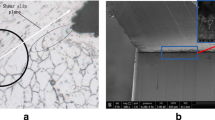Abstract
A general solution is given for the removal of a surface layer either by a sharp tool or by a peeling force. The creation of the separated layer is treated as a fracture process and analysed using an energy approach. For the cutting case frictional work at the tool-layer interface is included. Elastic cutting is first analysed and then that involving plastic bending which results in the layer curling. The transition from elastic to elastic-plastic bending occurs when \({\frac{\sigma_{y}^{2}h}{2EG_{c}}}\) . For small values of this parameter and high cutting angles there is a further transition to plastic shearing in the layer which leads to lower cutting forces. It is shown that both in this, and in some bending cases, there can be touching of the tool at the fracture which changes the nature of the process. The peeling case is shown to be a special, zero friction, version of cutting in which both elastic and elastic-plastic bending can occur. However plastic shearing is shown not to occur as it is energetically less favourable. Some comments on crack veering in high thickness cuts from mode II effects are made. Such deviations in direction can lead to none steady propagation.
Similar content being viewed by others
Abbreviations
- b :
-
Specimen width
- E :
-
Young’s Modulus
- E :
-
Strain
- e Y :
-
Yield strain
- F :
-
Transverse force
- F C :
-
Cutting force
- \({\hat{{G}}}\) :
-
\({\frac{\sigma _Y^2 h}{2E}}\)
- G b :
-
Energy release rate from bending
- G c :
-
Fracture toughness (energy per unit area)
- G d :
-
Dissipated energy per unit area
- G t :
-
Energy release applied to fracture point
- h :
-
Layer thickness
- h c :
-
Layer thickness after cutting
- k :
-
Radius ratio \({\frac{R_P }{R}}\)
- k o :
-
\({\frac{R_P }{R_O }}\)
- M :
-
Bending moment
- m :
-
Moment ratio \({\frac{M}{M_p}}\)
- M 1 :
-
Moment at first yield
- M o :
-
Bending moment at fracture point
- M P :
-
Fully plastic moment
- N :
-
Normal force on layer surface
- P :
-
Peeling force
- R :
-
Radius or curvature of layer
- R o :
-
Radius or curvature at fracture point
- R p :
-
Radius of curvature at yield
- S :
-
Shear force on layer surface
- u s :
-
Shear plane displacement
- U :
-
Energy or work
- ν :
-
Displacement
- U d :
-
Dissipated energy in layer
- U ext :
-
External work
- U f :
-
Frictional work
- x :
-
cutting or peeling length
- X :
-
\({\frac{Eh}{24\chi ^{2}G_c}}\)
- x c :
-
Layer length, \({\frac{dx_c }{dx}=\frac{h}{h_c}}\)
- δ c :
-
\({\frac{G_c }{\sigma _Y}}\) Crack opening displacement
- β :
-
Friction angle, tan−1(μ)
- χ :
-
Root rotation factor (0.64 in this case)
- \({\phi}\) :
-
Shear plane angle
- \({\phi_{o}}\) :
-
\({\phi}\) at minimum external work
- γ 3 :
-
\({\frac{2\chi e_Y }{\tan \frac{\theta }{2}}}\)
- γ s :
-
Shear strain
- γ 1,3 :
-
Functions of k o
- γ o :
-
\({\frac{2\chi e_Y}{\tan \theta}}\)
- μ :
-
Coefficient of friction
- θ :
-
Angle of cutting tool or peeling
- θ o :
-
Root rotation
- σ :
-
Stress
- σ Y :
-
Yield stress
- ψ :
-
Layer slope
References
Atkins AG (2003) Modelling metal cutting using modem ductile fracture mechanics: quantitative explanations for some longstanding problems. Int J Mech Sc 45(2): 373–396
Atkins T (2009) The science and engineering of cutting. Elsevier, ISBN, 978-0-7106-813+3
Cotterell B, Hbaieb K, Williams JG, Hadavinia H, Tropsa V (2006) The root rotation in double Cantilever beam and peel tests. Mech Mater 38: 571–584
Kinloch AJ, Lau CC, Williams JG (1994) The peeling of flexible laminates. Int J Fract 66(1): 45–70
Kinloch AJ, Williams JG (2002) The mechanics of peel tests. In: Dillard D, Docius AV (eds) On the mechanics of Adhesion, Adhesive science and engineering, Chapt. 8. Elsevier Science, pp 273–302
Merchant ME (1945) Mechanics of metal cutting Processes: 1. orthogonal cutting and a type-2 chips. J Appl Phys 16(5): 267–275
Thouless MD, Evans AG, Ashby MF, Hutchinson JW (1987) The edge cracking and spalling of brittle plates. Actc Metall 35: 1333–1341
Williams JG, Patel Y, Blackman BRK (2010) A fracture mechanics analysis of cutting and machining. Eng Fract Mech 77(2): 293–308



